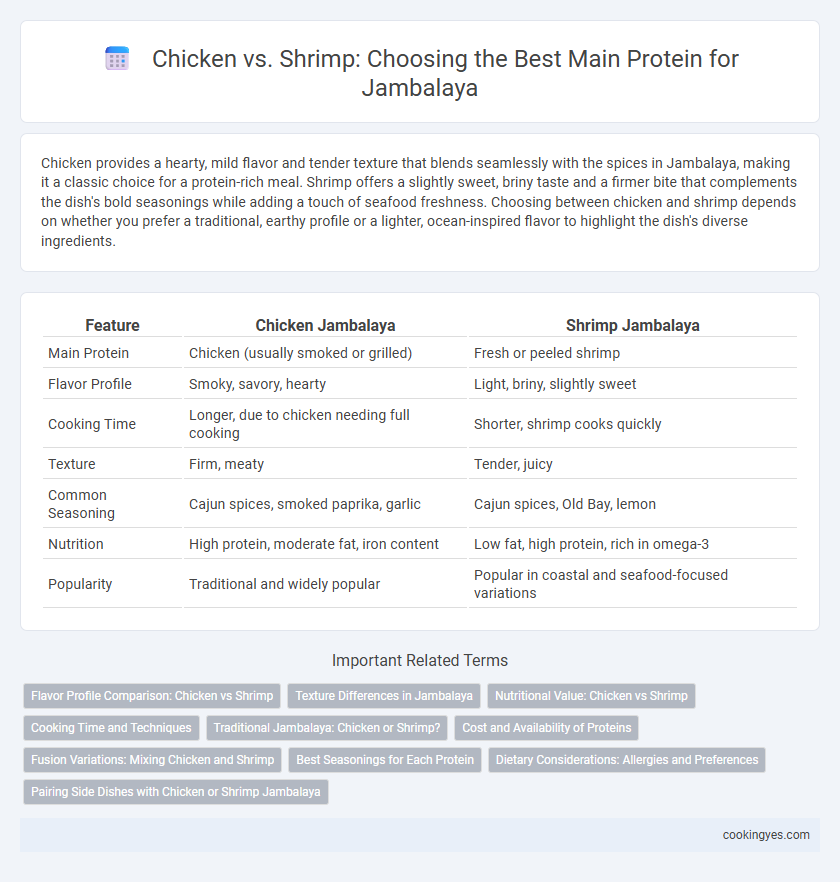Chicken provides a hearty, mild flavor and tender texture that blends seamlessly with the spices in Jambalaya, making it a classic choice for a protein-rich meal. Shrimp offers a slightly sweet, briny taste and a firmer bite that complements the dish's bold seasonings while adding a touch of seafood freshness. Choosing between chicken and shrimp depends on whether you prefer a traditional, earthy profile or a lighter, ocean-inspired flavor to highlight the dish's diverse ingredients.
Table of Comparison
| Feature | Chicken Jambalaya | Shrimp Jambalaya |
|---|---|---|
| Main Protein | Chicken (usually smoked or grilled) | Fresh or peeled shrimp |
| Flavor Profile | Smoky, savory, hearty | Light, briny, slightly sweet |
| Cooking Time | Longer, due to chicken needing full cooking | Shorter, shrimp cooks quickly |
| Texture | Firm, meaty | Tender, juicy |
| Common Seasoning | Cajun spices, smoked paprika, garlic | Cajun spices, Old Bay, lemon |
| Nutrition | High protein, moderate fat, iron content | Low fat, high protein, rich in omega-3 |
| Popularity | Traditional and widely popular | Popular in coastal and seafood-focused variations |
Flavor Profile Comparison: Chicken vs Shrimp
Chicken in jambalaya offers a savory and hearty flavor that absorbs spices well, creating a rich, comforting base. Shrimp provides a briny, slightly sweet taste with a tender texture that adds a fresh, oceanic contrast to the dish. The choice between chicken and shrimp significantly influences the jambalaya's complexity, with chicken delivering depth and shrimp enhancing brightness.
Texture Differences in Jambalaya
Chicken in jambalaya offers a firm, hearty texture that holds up well during slow cooking, providing a substantial bite that complements the dish's rich spices. Shrimp delivers a tender, slightly chewy texture that cooks quickly, adding a delicate contrast to the rice and vegetables. The choice between chicken and shrimp significantly impacts the mouthfeel, with chicken enhancing robustness and shrimp contributing a lighter, more succulent element to jambalaya.
Nutritional Value: Chicken vs Shrimp
Chicken in jambalaya offers a rich source of lean protein, high in niacin and vitamin B6, supporting energy metabolism and immune function. Shrimp provides a lower-calorie option, packed with selenium, vitamin B12, and omega-3 fatty acids, promoting heart health and brain function. Both proteins contribute essential amino acids, but shrimp's lower fat content and unique micronutrients make it a nutrient-dense choice for jambalaya enthusiasts.
Cooking Time and Techniques
Chicken and shrimp require different cooking times and techniques in jambalaya preparation. Chicken, often diced or sliced, needs to be fully cooked through, typically sauteed or simmered for 20-30 minutes to ensure tenderness and flavor absorption. Shrimp cooks rapidly within 3-5 minutes, usually added near the end to prevent overcooking and maintain a tender, juicy texture.
Traditional Jambalaya: Chicken or Shrimp?
Traditional jambalaya often centers on chicken as the main protein, providing a hearty and savory base that absorbs the dish's rich, spicy flavors. Shrimp offers a lighter, briny alternative that enhances the seafood notes typical of Creole cuisine. Both proteins deliver authentic taste profiles, with chicken emphasizing earthiness and shrimp highlighting coastal freshness.
Cost and Availability of Proteins
Chicken is often more cost-effective and widely available than shrimp, making it a budget-friendly choice for Jambalaya. Shrimp tends to be pricier and may fluctuate in availability based on season and location, impacting overall dish expenses. Selecting chicken can ensure consistent supply and affordability without compromising the authentic flavor of traditional Cajun cuisine.
Fusion Variations: Mixing Chicken and Shrimp
Fusion variations of jambalaya blend chicken and shrimp as main proteins, creating a harmonious balance of flavors and textures. Combining the tender, juicy quality of chicken with the sweet, briny taste of shrimp enhances the dish's complexity and appeal. This protein mix caters to diverse palates, making jambalaya a versatile and satisfying culinary experience.
Best Seasonings for Each Protein
Chicken in jambalaya pairs perfectly with robust seasonings like smoked paprika, garlic powder, thyme, and cayenne pepper, enhancing its savory, hearty flavor. Shrimp benefits from lighter, citrusy herbs such as parsley, lemon zest, and a touch of Old Bay seasoning, which complement its sweet, tender texture without overpowering. Both proteins thrive with a classic Creole spice blend, but tailoring seasonings to chicken or shrimp ensures balanced taste and improved flavor depth.
Dietary Considerations: Allergies and Preferences
Choosing chicken as the main protein in jambalaya offers a safer option for individuals with shellfish allergies, ensuring the dish remains accessible and enjoyable. Shrimp provides a distinct seafood flavor but poses a risk for those with shellfish sensitivities and may not suit all dietary preferences. Considering these allergy and preference factors is essential for creating a jambalaya that accommodates diverse dietary needs.
Pairing Side Dishes with Chicken or Shrimp Jambalaya
Chicken jambalaya pairs perfectly with crisp green salads and buttery cornbread, enhancing its rich, smoky flavors. Shrimp jambalaya complements light, citrusy side dishes like lemon garlic asparagus or a fresh tomato cucumber salad, balancing the seafood's natural sweetness. Choose sides that highlight the main protein, creating a harmonious and flavorful meal experience.
Chicken vs Shrimp for main protein Infographic

 cookingyes.com
cookingyes.com